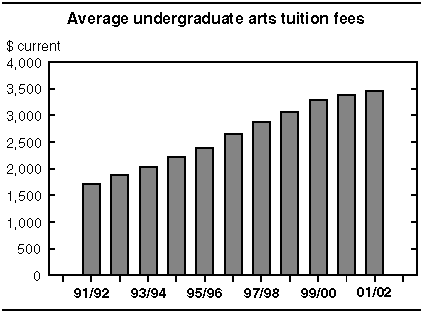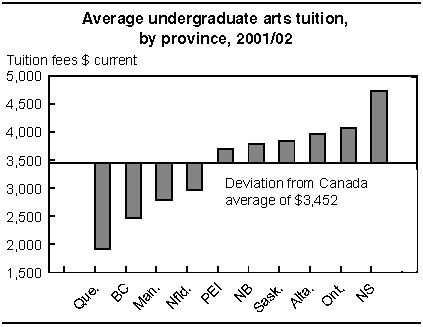
















 |
|
 |                |
Archived ContentInformation identified as archived is provided for reference, research or recordkeeping purposes. It is not subject to the Government of Canada Web Standards and has not been altered or updated since it was archived. Please "contact us" to request a format other than those available. 
The Daily. Monday, August 27, 2001 University tuition fees2001/02Undergraduate arts students will pay an average of 2.1% more in university fees for the 2001/02 academic year. This is the smallest increase since 1978/79, when tuition rose 1.4%. This fall, undergraduate arts students will pay an average of $3,452 in tuition, up 2.1% from $3,381 in 2000/01. This is double the average tuition of $1,714 in 1991/92, the result of significant increases during the 1990s. Between 1990/91 and 2000/01, tuition fees rose 126.2%, or six times faster than the 20.6% increase in inflation as measured by the Consumer Price Index. 
However, university tuition fees in public institutions have stabilized in the past two years. The 2.1% increase in 2001/02 follows a 3.1% increase in 2000/01. Over the five years previous to 2000/01, tuition rose by an annual average of 7.3%. Average tuition fees will increase at universities in six provinces: Prince Edward Island, Nova Scotia, New Brunswick, Ontario, Saskatchewan, and Alberta. For the second consecutive year, the largest average rise will be in Saskatchewan, 12.4%. However, average undergraduate arts fees of $4,732 in Nova Scotia remain the highest in Canada. 
The average undergraduate arts tuition at Ontario universities, $4,062, remains the nation's second highest. The 2.3% fee increase falls well below Ontario's average annual tuition rise of 10.1% over the previous five years. Tuition fees will drop 10.0% in Newfoundland and 2.2% in British Columbia. This marks the seventh consecutive year that British Columbia universities have frozen or lowered tuition fees. For the fifth consecutive year, tuition fees will be frozen at $1,668 for residents of Quebec attending university in Quebec. Students from other provinces attending Quebec universities face a 7.4% increase in tuition this fall. Manitoba will also freeze its tuition fees. The lowest undergraduate fees in Canada will be for university students who are residents of Quebec. They will continue to pay less than half the tuition fees of those in other provinces in virtually all fields of study. Dentistry, medicine, law have highest fees and increasesThe most expensive programs, measured by average tuition, continue to be dentistry, medicine, and law. They also face the largest fee increases in 2001/02. Average tuition fees(1)
Students in dentistry will pay $8,491 on average this fall, up 7.8% from 2000/01. Students in medicine will pay $6,654 on average, up 9.9% from 2000/01. Law students will pay an average of $4,355, up 8.2% from 2000/01. Average dentistry fees will be highest in Saskatchewan and Ontario. Tuition fees for medicine and law will be highest in Ontario and Nova Scotia. Reduced government funding partly offset by higher tuition feesSince 1991/92, undergraduate arts fees have more than doubled in Nova Scotia, Ontario, Saskatchewan and Alberta. The largest increase occurred in Alberta, where average tuition fees paid by undergraduate arts students rose more than two and a half times from $1,522 to $3,970. More recently, tuition fees climbed more than one-third since 1996/97 in Saskatchewan (+44.2%), Ontario (+38.4%), New Brunswick (+36.7%) and Nova Scotia (+35.2%). In British Columbia, arts tuition fees rose from $1,911 to $2,465 from 1991/92 to 2001/02. This increase of less than 30% was the lowest among the provinces. In the past five years, tuition fees fell 6.6%; British Columbia now has the second lowest average arts fees, after Quebec. According to the most recent data on university finances, released in The Daily on July 30, government funding to universities rose 15.1% in 1999/00. The major sources of this additional funding were the provincial governments for capital expenditures, and the federal government in support of research. Despite these increases, the share of total university revenue from government grants and contracts in 1999/2000 was unchanged from the previous two years at 55%, following nearly two decades of steady decline. In 1989/90, government contributions made up 69% of university revenues. In 1999/2000, tuition fees represented 16% of total university revenue, compared with 9% in1989/90. To help partly offset rising tuition, universities increased their expenditures on scholarships and bursaries in 1999/00 by 23.9%. Between 1989/90 and 1999/2000, scholarships and bursaries' share of expenditures more than doubled from 1.5% to 3.3%. Graduate fees rise more rapidlyFor the fifth consecutive year, students in graduate programs will face higher average fee increases than their undergraduate counterparts. In 2001/02, they will pay an average of $4,360 in tuition, up 9.8% from 2000/01. Since 1997/98, fees for graduate programs have risen about 11.2% per year, compared with 6.3% a year for undergraduate programs. Graduate fees are reduced 10% in Newfoundland and frozen in Manitoba. Graduate fee increases are largest in Alberta, Ontario, British Columbia and Saskatchewan. Tuition fees for international students at the undergraduate or graduate level will increase at public universities in most provinces, by between 0.5% and 39.2% depending on the institution and field of study. The exceptions are Newfoundland, Manitoba and British Columbia, where such fees are frozen. Information is also available on additional compulsory fees and the cost of accommodation on campus. For more information, or to enquire about the concepts, methods or data quality of this release, contact Client Services (1-800-307-3382; 613-951-7608; fax: 613-951-9040; educationstats@statcan.gc.ca), Centre for Education Statistics. Average undergraduate arts tuition(1)
| |||||||||||||||||||||||||||||||||||||||||||||||||||||||||||||||||||||||||||||||||||||||||||||||||||||||||||||||||||||||||||||||||||||||||||||||||||||||||||||||||||||||||||||||||||||||||
|
|
|